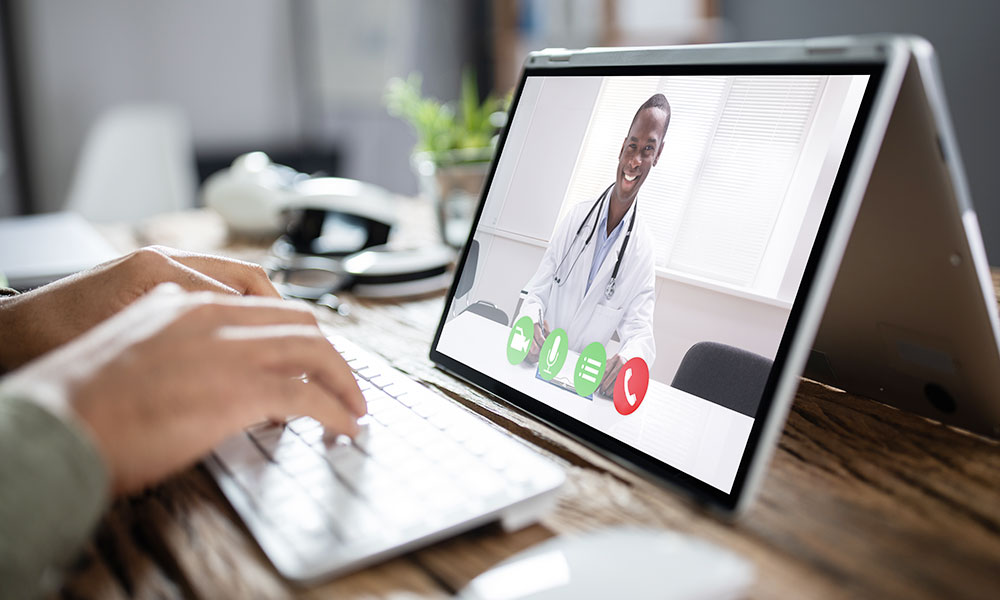Changes in reimbursement due to COVID-19 have made possible surge in use of telemedicine
By Deborah Jeanne Sergeant

Chris Battles
Using technology to access healthcare isn’t new but it looks like the pandemic-fueled surge in telehealth will continue even after the pandemic wanes.
Loretto, which has adopted the technology for years, early in April announced that its existing telehealth program expanded to help keep residents and participants safe at home. Using the MonitorMe, a real-time system, Loretto could keep tabs on vital signs through a disposable patch. It monitors temperature, blood pressure, blood sugar, pulse, heart rate and more. An off-site medical team tracks information and Loretto staff is notified if anything is amiss. The system also allows participants to connect to clinicians any time via audio or visual through the accompanying app on a tablet.
Medicare and Medicaid cover the program.
“Loretto has been using telehealth for years, but this is a welcomed addition at a critical time for our residents and participants.” said Joelle Margrey, vice president of skilled nursing and rehabilitation at Loretto. “Telehealth programs like MonitorMe allow our residents and PACE-CNY participants to have access to medical attention while staying indoors and staying safe.”
The organization introduced its first telehealth initiative, ImagineMIC, in 2018 at its restorative care unit, and since included PACE-CNY and residents at Cunningham Skilled Nursing and the Fahey rehabilitation buildings.
“Telemedicine is here to stay,” said physician Ned Ruhotina, affiliated with Associated Medical Professionals, a large urology practice based in Syracuse with office in Oswego County.
The organization began using telemedicine for more routine visits and for follow-up visits during the pandemic and continues to use it to reduce the traffic in the office. Ruhotina said that telehealth also helps the practice connect with patients challenged to get to the office and protect those who are immunocompromised.
“Hopefully, with congressional action, we’ll continue to provide this for the foreseeable future,” Ruhotina said.
Initially, reimbursement issues made offering telehealth difficult; however, President Trump has been working to deregulate healthcare. Once he declared a national emergency because of COVID-19 and the Secretary of the Department of Health and Human Services declared a public health emergency Jan. 31, the Centers for Medicare and Medicaid Services released an advisory March 17 that permitted Medicare to reimburse providers for telehealth services nationwide.
“The legislation passed because of COVID-19 made telehealth available to much more of the population,” said Chris Battles, licensed mental health counselor with Equanimity Counseling in Oswego.
He said that some patients prefer in-person sessions and that telehealth does diminish the clinician’s ability to observe cues. A head-and-shoulders view would obscure considerable body language, for example.
Battles thinks that overall, telehealth is working well for many patients. In some ways, it’s better than meeting in the office with patients, such as convenience. It’s also helpful for clinicians, who can “see into people’s lives in a different way.”
For example, a provider can see home and lifestyle factors that may influence the patient’s condition that would otherwise not be evident.
“There’s a time and place to stop at the office,” Battles said. “Telehealth is largely good and helpful.”
Geoff Hopkins, board-certified psychiatrist with St. Joseph’s Health, said that telehealth use is growing among mental health providers during the pandemic.
“All the major mental health clinics have initiated telehealth platforms,” Hopkins said. “The substance use disorder clinics in town have done group therapy with telehealth to attempt to maintain an ability for people to stay in treatment.”
He added that in-patient facilities did not close for emergency need for de-toxification.
“It’s been a heroic undertaking for substance abuse facilities and mental health providers to provide services,” Hopkins said.
Simply having patients wait out the pandemic isn’t an option, especially considering that the pandemic contributes to exacerbating existing mental health conditions. Those undergoing treatment pre-pandemic can’t hit the pause button. This holds true of people with substance abuse problems.
Telehealth has helped in keeping patients on track
“Most people who are successfully abstinent are either in a treatment program or they almost always have a formal, organized support system,” said Jack Houck, Ph.D. with Psychological Health Care in Syracuse and private practice. “Usually, it’s through an agency. With this whole lockdown, they would lose that.”
He thinks that telehealth has been helpful in keeping patients on track and will likely continue to have a strong presence in mental health, as many other challenges could keep patients from treatment, including stigma, weather, lack of transportation, lack of childcare and scheduling conflicts.
The Department of Health and Human Services Office for Civil Rights began allowing providers leniency on their methods of providing telehealth relating to HIPAA rules. Any non-public platforms such as Zoom, Skype, and FaceTime are permitted during the national emergency.
Expanding the use of telehealth has helped Rosemary Squires, registered dietitian at Holistic Path to Wellness in Central Square, continue working with clients in her private practice.
“A lot of people are comfortable with it,” Squires said. “Moving forward, I think it will be the way of the future. They can use it straight from their phone to do a virtual session. I had offered it before the pandemic, but there really wasn’t much of a demand for it. Most of my clients were local. But I’m also getting more clients who are farther away.”
She chooses to use SimplePractice software to connect via video. SimplePractice also provides paperless recordkeeping, billing and scheduling. The platform had initially been used by mental health professionals; however, Squires said that it has since branched out to include other types of healthcare.
Perception of telehealth has shifted as well. Even a decade ago, a virtual meeting from one’s home was viewed by some people as less professional; however, in today’s gig economy and especially in light of quarantine, telehealth from home carries little if any stigma. Squires thinks it can even help patients feel more comfortable.
Squires hosts virtual sessions from her home office and turns on a fan for white noise to obscure any household sounds. Having clients see a provider at home “makes you more relatable,” she said.
It can also help clients feel more at ease since they’re also in their own homes. Visiting a clinical setting may feel impersonal to some.
Telehealth makes some sessions easier for the dietitian when discussing specific foods for examples.
“If I’m conferencing a client at home, they can grab a food item from their cupboard to show me; they’re right there,” Squires said.
She plans to continue to use telehealth.
Excellus: Telemedicine Soars in Wake of Pandemic
The number of health care visits delivered via telemedicine technology spiked recently as health care providers continue to “see” their patients while practicing physical distancing.
“When we chart our member usage of telemedicine, we see a steep, nearly vertical rise in the line graph,” said Marya Vande-Doyle, director of workplace wellness and telemedicine for Excellus BlueCross BlueShield. “It’s not an overstatement to say that patients and their providers have wholeheartedly embraced this method of care.”
Excellus BCBS members logged nearly 40,000 telemedicine visits between Jan. 1 and April 3, or about 14,500 more visits than were made in all of last year. In 2019, the health plan had a total of 23,767 telemedicine visits. Extrapolating its member experience across the entire state population, Excellus BCBS estimates that New Yorkers used telehealth benefits 470,000 times in the first three months of 2020.
To encourage the use of telemedicine and eliminate roadblocks to getting care, Excellus BCBS expanded telehealth coverage to all members and waived any member cost-share responsibility for telemedicine services, regardless of the medical issue.
An estimated 60 percent of telemedicine visits made by health plan members in the first quarter of 2020 were related to medical treatments, with the balance (40 percent) related to behavioral health services. Behavioral health specialists include psychiatrists, social workers, psychologists, counselors and nurse practitioners.




